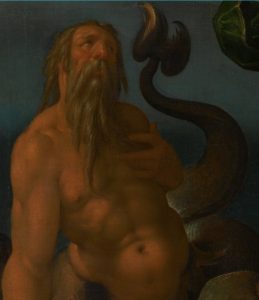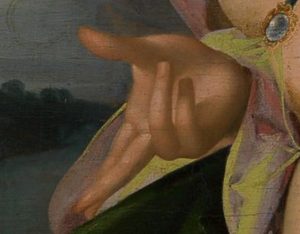Scylla was not always the man-eating cliff-dwelling creature that devoured seafarers and their crews. Scylla came to be all that after Circe’s magical potions transformed her into the atavistic horror Odysseus met first-hand. In her earlier existence, Scylla was once a comely young woman whom many a male courted … and bedded.

Madeleine Miller’s Circe (2020) explores the psychological battle between the witch and her rival, Scylla. Miller draws deeply on classical sources that tell how Glaucus the fisherman fell in love with Scylla who snubbed him. Ovid, his forebears ,and his successors tell that when Glaucus appealed to Circe — who wanted Glaucus for herself — for help with his plight, she ruined out of sheer jealousy first the unwitting Glaucus then Scylla. Was Scylla’s punishment at Circe’s hands condign?
Bartholomeus Spranger weighed in on the question of Scylla’s innocence in his picture called “Glaucus and Scylla” (1581). Scylla is shown in the moment of spurning Glaucus, the piscine monster. He clutches his heart as he looks
longingly up at the voluptuous mostly-nude object of his erotic attention. Such plaintive expressions might sway the heart of a more pliable girl. Scylla, as Spranger presents her, may be even less innocent than Glaucus would hope. Her right hand may say more about Scylla than first meets the eye and seems to tell Glaucus that his attempts to woo her will enjoy no pleasant outcome.

Spranger’s Scylla gestures to Glaucus in a suggestively discouraging way, perhaps demonstrating that Glaucus’ attempts to pursue her will find no welcome end. One should note that her crossing of the index over the middle finger is not the common expression of “good luck”, which crosses the middle over the index. That crossed-finger iconically dates to early Christian digital symbols of the cross. Spranger’s inversion, instead, seems to feature the extended middle finger, a timeless gesture that bares the extended digitus impudicus, as the Romans called “the bird”. Scholarly argument shows that as far back as Aristophanes and Martial nearly every gesture made with the middle-finger connotes menacing sexual meaning — meanings that gravitate toward suggesting that the targeted person is considered by the gesturing person to be less virile, i.e. vulgar phallic insults. (Nelson)
Spranger was one of the painters in the court of Rodolf II of Prague. He was engaged with his peers in asserting that painting be held in the high esteem of the other Liberal Arts. According to their movement, “the visual arts could claim to follow the same principles as did the other arts, including, most pertinently for questions of style, rhetoric.” (Kaufmann) To this end, Spranger and his peers adeptly make their two-dimensional canvases rhetorical. They speak.

“The middle-finger jerk is one of the oldest sexual insults known.” (Morris) Here Scylla does not merely shun Glaucus; she rudely rejects his expression of infatuation by flipping him off.
OGCMA ScyllaCrataeis2.0003_Spranger = Glaucus1.0003_Spranger
Bartholomeus Spranger, 1546-1611, “Glaucus and Scylla,” ca 1581, oil on canvas, Vienna, Kunsthistorisches Museum, Gemäldegallerie, inv. 2615 (1502B). — www.khm.at/de/object/1813/
Miller, Madeleine. 2020. Circe, a novel. New York: Little, Brown and Company.
Morris, Desmond. 1994. Bodytalk: a world guide to gestures. London: Jonathan Cape.
Nelson, Max. 2017. “Insulting Middle-Finger Gestures among Ancient Greeks and Romans.” Phoenix 71: 66–88. https://doi.org/10.7834/phoenix.71.1-2.0066.
Kaufmann, Thomas DaCosta. 1985. “Hermeneutics in the History of Art: remarks on the reception of Dürer in the sixteenth and early seventeenth centuries.” In New Perspectives on the Art of Renaissance Nuremberg: five essays, ed. By J. C. Smith. College of Fine Arts, University of Texas at Austin. 23-39.



